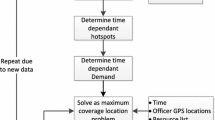Abstract
In order to adequately respond to emergencies, it is necessary to maintain a sufficient level of personnel as well as geographic coverage. Planning for geographic and manpower coverage can involve a wide variety of factors, including union restrictions, frequency and spatial distribution of calls, and road network accessibility. The focus of this paper is on manpower deployment across such agencies as police, fire, and EMS. Since the cost of manpower is the single largest cost factor in providing such services, it is also one of the central elements in efficient service provision. This paper discusses some of the differences in manpower planning among the different emergency services. It also presents details associated with several special models that have been developed in police and EMS planning in order to efficiently deploy manpower throughout each week. We conclude with comments on future needs for research and development in deployment planning and operations.
Similar content being viewed by others
References
K. Chelst, “A Public Safety Merger in Grosse Point Park, Michigan—A Short and Sweet Study,” INTERFACES, vol. 18, 1988, pp. l–l1.
K.R. Chelst, “Quantitative Analysis of Police and Fire Mergers and a Study of a Medium Sized City,” Final Report to the National Institute of Justice, 81-IJ-CX-0076.
A.J. Swersey, L. Goldring, and E.D. Geyer “Improving Fire Department Productivity— Merging Fire and Emergency Medical Unitsin New-Haven,” INTERFACES, vol. 23, 1993, pp. 109–129.
W.E. Walker, J.M. Chaiken, and E.J. Ignall, Fire Department Deployment Analysis: A Public Policy Analysis Case Study (The Rand Fire Project), New York, NY: North Holland, 1979.
C. Toregas, R. Swain, C. ReVelle, and L. Bergman, “The Location of Emergency Services,” Operations Research, vol. 19, 1971, pp. 1363–1373.
D.A. Schilling, C. ReVelle, J. Cohon, and J. Elzinga, “Some Modelsfor Fire Protection Location Services,” European Journal of Operational Research, vol. 5, 1980, pp. l–7.
P. Kolesar, and E.H. Blum, “Square-root Laws for the Fire Engine Response Distances,” Management Science, vol. 19, 1973, pp. 1368–1378.
D. Colner, and J.F. Gilsinn, “Fire Service Location-Allocation Models,” NBS Technical Note 774, U.S. Department of Commerce, National Bureau of Standards, Washington, DC, 1973.
J. Stout, “System Status Management: The Strategy of Ambulance Placement,” The Journal of Emergency Medical Services, May 1983.
R.C. Larson, “A Hypercube Queuing Model for Facility Location and Redistricting in Urban Emergency Services,” Computers and Operations Research, vol. 1, 1974, pp. 67–95.
M. Daskin, “A Maximum Expected Covering Location Model: Formulation, Properties, and Heuristic Solution,” Transportation Science, vol. 17, 1983, pp. 48–70.
V. Marianov, and C.S. ReVelle, “The Queueing Maximal Availability Location Problem: A Model for Siting Emergency Vehicles,” European Journal of Operational Research, vol. 93, 1996, pp. 110–120.
M.B. Mandell, “Covering Models for Two-tiered Emergency Medical Service Systems,” Location Science, vol. 6, 1998, pp. 355–368.
F.C. Mendonca, and R. Morabito, “Analysing Emergency Medical Service Ambulance Deployment on a Brazilian Highway Using the Hypercube Model,” Journal of the Operational Research Society, vol. 52, 2001, pp. 261–270.
C.C. Branas, E.J. MacKenzie, and C.S. ReVelle, “A Trauma Resource Allocation Model for Ambulances and Hospitals,” Health Services Research, vol. 35, 2000, pp. 489–507.
D.J. Eaton, M.S. Daskin, D. Simmons, Bulloch, and G. Jansma, “Determining Emergency Medical Service Deployment in Austin, Texas,” INTERFACES, vol. 15, 1985, pp. 96–108.
A.J. Mason, D.M. Ryan, and D.M. Panton, “Integrated Simulation, Heuristic, and Optimization Approachesto Staff Scheduling,” Operations Research, vol. 46, 1998, pp. 161–175.
R.G.J. Mills, and D.M. Panton, “Scheduling of Casino Security Officers,” OMEGA International Journal of Management Science, vol. 20, no. 2, 1992, pp. 183–191.
P.E. Taylor, and S.J. Huxley, “A Break from Tradition for the San Francisco Police: Patrol Of.cer Scheduling Using an Optimization-based Decision Support System,” INTERFACES, vol. 19, 1989, pp. 4–24.
Author information
Authors and Affiliations
Rights and permissions
About this article
Cite this article
Church, R., Sorensen, P. & Corrigan, W. Manpower Deployment in Emergency Services. Fire Technology 37, 219–234 (2001). https://doi.org/10.1023/A:1012435618668
Issue Date:
DOI: https://doi.org/10.1023/A:1012435618668




